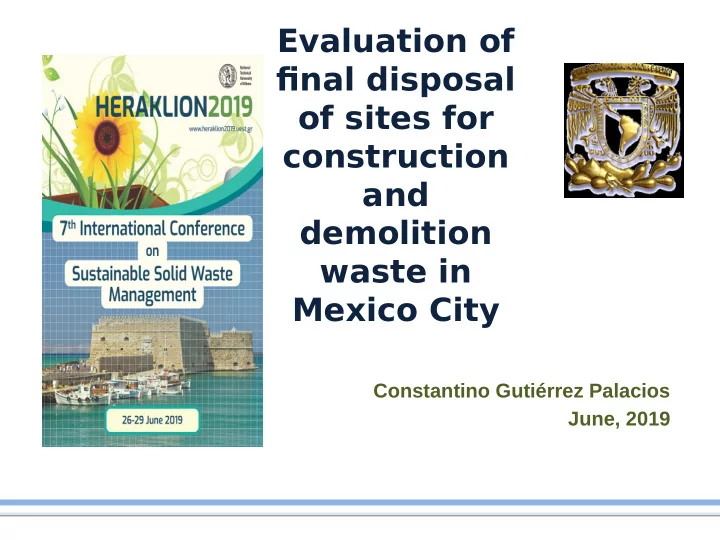

Evaluation of fjnal disposal of sites for construction and demolition waste in Mexico City Constantino Gutiérrez Palacios June, 2019
Introduction In Mexico, Construction is an important industry; it generates 5,6 million jobs in the total country.
Construction and Demolition Wastes (C&DW In Mexico City there are a generation about 14.000 tons/day of C&DW [Sedema, 2019] but there is not a suitable site to dispose of these wastes
Open dumping outside Mexico City (Environmental negative impacts)
In this work a multi-criterion evaluation methodology was applied to find a suitable location of a final disposal of site of Construction and Demolition Waste (C&DW), in Mexico City.
Objetive To analyze options to determine the suitable place for final disposal of construction and demolition waste, in Mexico City.
Materials and methods Materials : • Description of the study area • Field search • Sites Through this method,12 sites evaluation were analyzed Figure 1. Preliminary delimitation of possible sites
Materials and methods • The hierarchical scheme of the used technique (EMC), has three basic levels: final goal, decision criteria (usually accompanied by sub-criteria), and solution alternatives [Malczewski and Rinner, 2015]. The general function is represented in Equation 1. ........... (1) • Where v(a ik ) is the value function, w l is the weight associated with the l th objective (l = 1, 2 ..., p), and w k (l) is the weight assigned to the k th attribute associated with the l th objective.
Materials and methods • In order to use the MCE technique, there were use all variables and criteria which have an important impact on the host or reception capacity of the territory.
The steps involved in the evaluation using the EMC-AHP technique are: 1. Identifjcation of relevant criteria and / or sub-criteria. 2. Construction of a model of the hierarchical analytical process. 3. Performing pairwise comparisons of the elements on the same level with respect to the elements. 4. Calculation of the weights derived from the paired comparisons, generating the corresponding matrices. 5. T est of the consistency of the generated matrices, by calculating the consistency ratio. 6. Repeat steps 3, 4 and 5 for all elements at all hierarchical levels. 7. Synthesis of all weights for the elements in each level. 8. Evaluation of total consistency.
Hierarchical scheme • The fjrst level in the hierarchical scheme, is the goal that is intended to reach. • The second level was called general criteria (GC), and it was divided into 3 areas: " environmental, socio-economic and technica l”. • The third level corresponds to the variables employed; this level was called specifjc criteria (SC), divided in two aspects: "factors and limitations"
Hierarchical scheme used in the EMC Permeability of soil Involvement of the topsoil Factor s Involvement of the fauna in site Involvement of present surface water Environment al criterion Areas of natural importance Limiti Impairment of the quality of the air and ng noise Distance to population areas Goal: Land use / Cultivation areas Socio - economic Factors Communal acceptation Optimal criterion Feasibility of land acquisition site Job offers for the work selection Land cost Limiting Presence of groups or organizations of protest Proximity to area of origin of the CD&W Access roads Topography of the terrain Factors Carrying capacity of the floor Water catchment Flown of traffic Technical Ground deformation criterion Presence of urban infrastructure Presence of water infrastructure Manifest problems of flooding Limiting Presence of faults and factors at the side infrastructure
Materials and methods Methods: • Localization criteria: factors and limitations. • Weighting of criteria and sub-criteria: Using comparison that is based on a system of qualifjcation by importance. • Standardization of criteria: T o normalize levels or categories of each variable or SC, applied a simple appraisal of values ranging from 1 to 3 for the factors, and 0 or 3 to the constraints; in this assessment, the smaller values correspond to the most unfavorable or restrictive condition, while the highest values are equivalent to the favorable condition. ..
Results and discussion • Final quilifjcación => 1,9 Viable site. • 1,8 =< Final quilifjcación < 1,9 Medium-Viability site • Final quilifjcación < 1,8 Non-viable site. Figure 6. Results of evaluated sites with the three considered criteria
Results and discussion Sites with higher scores Figure 6. Xico 1 Figure 4.Camino al Ajusco Figure 5. Xico 3 • Camino al Ajusco”, “ Xico 3” and “Xico 1”, obtained the highest scores, since they complied with the variables of the environmental, technical and socio-economic criteria; being the last one the most important.
Conclusion • The methodology presented, evaluated and determined the most viable sites regarding environmental, socio-economic and technical variables. The sites that obtained the highest scores were: Camino al Ajusco, Xico 1 and Xico 3. Finally, it is important to mention that, Multi-Criteria Evaluation methodology could be applied to similar studies in difgerent regions of Mexico.
References • Cámara Mexicana de la Industria de la Construcción. (2013). Plan de manejo de Residuos de la Construcción y la Demolición . Available in: http://www.fjc.org.mx/OTTIC/CMIC/PMrcdCompleto.pdf • Gaceta Ofjcial del Distrito Federal. (26 de febrero de 2015). Norma Ambiental para el Distrito Federal NADF-007-RNAT-2013, que establece la clasifjcación y especifjcaciones de manejo para residuos de la construcción y demolición, en el distrito federal. • Gómez, M. & Barredo, J. (2005). Sistemas de Información Geográfjca y Evaluación Multicriterio en la Ordenación del T erritorio. 2a ed. Madrid: RA-MA. • Saaty T.L. (1980). The Analytic Hierarchy Process, McGraw-Hill, New York. • Malczewski, J. & Rinner, C. (2015). Multicriteria Decision Analysis in Geographic Information Science . New York: Springer Science+Business Media. • Instituto Nacional del Federalismo y Desarrollo Municipal NAFED (2010). Enciclopedia de los municipios y delegaciones de México, Distrito Federal. Available in: http://siglo.inafed.gob.mx/enciclopedia/EMM09DF/
gupc@unam.mx cgping@yahoo.com
Recommend
More recommend